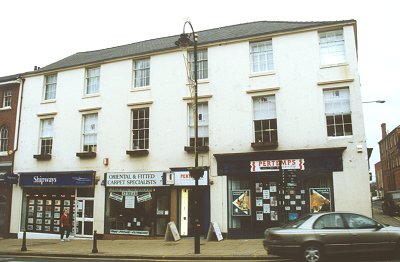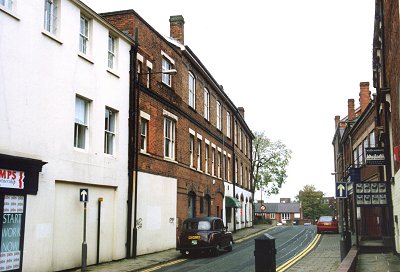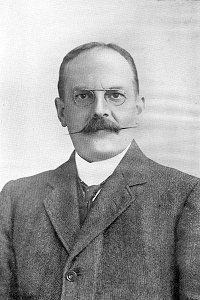THE HISTORY OF ELECTRICITY
SUPPLY IN THE AREA
|
III
Electricity supply in Wolverhampton
|
|

The Commercial Road power station. |
The Wolverhampton electricity supply was inaugurated
on 30th
January, 1895, when Sir Gerald Mander was the Mayor and also the
chairman of the Electricity Committee. The opening ceremony was
performed by Lord Kelvin, a great pioneer of electrical engineering
and, at the time, the President of the Royal Society. |
| The generating station was in Commercial Road,
Wolverhampton, a building which still stands. Its
cooling tower remained as a landmark until recent years. It was coal
fired, most of the coal coming in by canal. The equipment consisted
of three sets with a total capacity of 350 KW. It was supplied
by the E.C.C. and was a D.C. system, where the central generating
station produced 1,000 volts. This was distributed to a number
of small sub-stations which were scattered across the town.
Each sub-station contained a motor-generator to convert the incoming
1,000 volt supply to 200 volts. D.C.. This system was favoured
by the E.C.C. after a successful installation in Oxford.
Similar systems were later installed by the company at Birmingham,
Manchester, Walsall, Hull, Barrow-in-Furness, Charing Cross,
Chelsea, Sydenham and Shoreditch.
The 1914 Wolverhampton Red Book provides an interesting
account of the state of play at the time, which is reproduced here in
extenso:
The present plant has a capacity of 6,400 K.W., and
consists of five continuous current Generators, direct coupled to
high-speed steam engines, and three Turbine-driven Alternators. The
Turbines were made by Willans and Robinson, of Rugby, and two of the
engines by the same firm, the others being by Bellis and Morcom, of
Birmingham.
The Generators have all been supplied either by the
Electric Construction Company, Ltd., or Thomas Parker Ltd.
The Boiler Plant consists of six Lancashire, two
Economic and four Babcock and Wilcox Boilers with Economisers and
induced draught plant.
Water-softening Plant is installed for treating the
water before it is fed to the boilers. The coal for use under the
boilers is brought to the works by canal in the Department’s own boats,
and is mechanically conveyed from the boats to storage bunkers fixed
above the boiler house.
A large Storage Battery, by the Chloride Battery Co., is
also installed at the Main Generating Station.
There is an Auxiliary Generating Station at the Refuse
Destructor, Crown street, containing plant having a capacity of 750 K.W.
Direct current supply is given throughout the borough at
pressures of 220 and 440 volts for lighting and power purposes, and a
three-phase bulk supply is given to large consumers at 6,000 volts 50
frequency [sc. 6,000 volts and at a frequency of 50 Hz] , which
is transformed down to 400 and 230 volts for power and lighting purposes
respectively.
Several Sub-stations have been built to contain
converting machinery for supplying districts situated a long way from
the Generating Station.
The Tramway system is run by Electricity supplied from
the Main Generating Station, a special Switchboard and Mains being
installed for this purpose.
The rates charged for Electricity are very low,
comparing favourably with those charged in other towns, and the
consumption of Electricity per head of population is in consequence very
high.
During the last twelve months a new system of charging
for private houses has been instituted. This consists of a fixed annual
charge equal to 15 per cent. of the rateable value of the house, plus a
small charge per unit consumed. The object of this system is to
encourage the use of Electricity in private houses for heating, cooking
and other purposes. Many consumers have taken advantage of the new
system and are installing heating and cooking apparatus with eminently
successful results.
|

The Wolverhampton electricity department's showrooms were here,
facing Darlington Street . |
In the same edition the Electricity Department has a
full page (unillustrated) advertisement announcing that "Wiring, &c,
for lighting, heating & cooking installations together with heaters
and cookers, supplied on Hire at low terms". Details of the prices
can be obtained either from the Corporation Electricity Works in
Commercial Road or from The Corporation Electricity Showrooms,
Darlington Street. |
| In the 1922-23 Wolverhampton Red Book
the advertisement is much the same but gives the Central
Administrative Offices as being at 83 Darlington Street, which is on
the corner of Darlington Street and Red Lion Street.
They also had premises in Red Lion Street itself, behind the
Town Hall.
The text has changed only to give a more up to date account of
the equipment: |

The offices and depot were in the buildings running along
Red Lion Street: The Electricity Department's depot was a bit lower
down the hill in Clarence Street, roughly where Crown House now is. |
|
The present
main Generating Station has been entirely reconstructed, and has now a
modern up-to-date equipment with a total output of 23,000 Kilowatts. The
plant consists of seven steam Turbine-driven Alternators; the steam
portion by Willans and Robinson, of Rugby, and the British
Thomson-Houston Company, Ltd., of Rugby; Generators and electrical
portion by Siemens Bros., Ltd., of Stafford; the British Thomson-Houston
Co., Ltd., of Rugby; and the Electric Construction Co., Ltd., of
Wolverhampton.
The Boiler Plant consists of large and modern Stirling
and Babcock and Wilcox Water-tube Boilers, with Economisers, induced and
forced draught plant. Water-softening plant is installed for treating
the water before it is fed to the boilers. The coal for use under the
boilers is brought to the works by canal in the Department's own boats,
and is mechanically conveyed from the boats to storage bunkers fixed
above the boiler house, and from thence automatically into the furnaces.
|

S. T. Allen, Wolverhampton Borough's Electrical Engineer in the
1920s. |
The area of supply covered in 1895 was that of the
Borough at the time, about 5.5 square miles. From then on there was
continuous expansion of the area. Under the Wolverhampton
Corporation Electric Lighting Extension Order, 1913, the area
doubled to 11 square miles by the inclusion of the Parish of
Bushbury in the area of supply. At that time Bushbury was mainly
rural but the supply of electricity probably contributed to its
becoming a major area for the industrial and residential expansion
of Wolverhampton. The 1925 Order more than quadrupled this size to
47 square miles, taking in, amongst other places, Brewood and
Codsall. The Borough's own Acts of Parliament in 1928 and 1932
extended the area to 106 square miles. Nearly all of this
expansion was in the directions away from the Black Country and into
the rural areas to the north and west. |
| By 1932 the supply area reached Saredon and Penkridge
to the north east, Brineton and Blymhill to the north east, and
Tong, Albrighton and Pattingham in the west. |

|
|

|
|

|
| Return to the
previous page |
|
Return to the
beginning |
|
Proceed to the
next page |
|